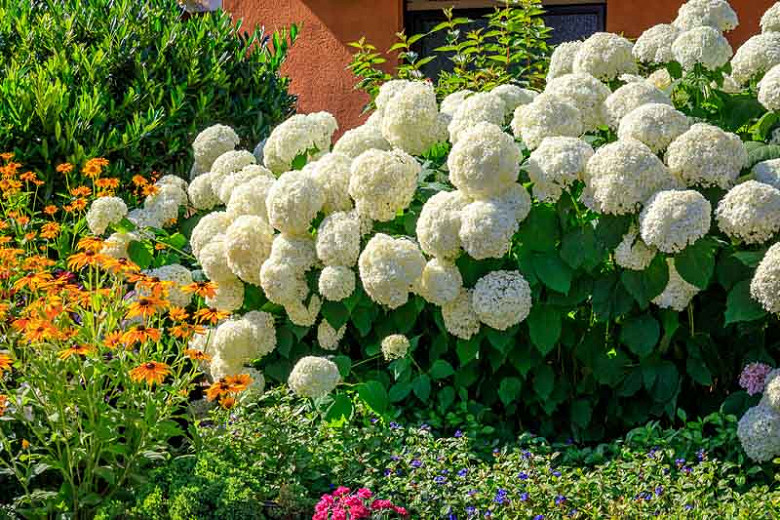The Easytogrow Hortensia Arborescens
The Easy-to-Grow Hortensia Arborescens
Hydrangea arborescens, also known as smooth hydrangea, is a popular garden plant that is known for its large, showy blooms. These hydrangeas are relatively easy to grow and care for, making them a good choice for gardeners of all skill levels.
In this blog post, we will discuss the basic care requirements for hortensia arborescens, including soil, sunlight, water, fertilizer, and pruning. We will also provide some tips on how to prevent pests and diseases.
Soil
Hortensia arborescens prefers moist, well-drained soil. The soil should be rich in organic matter, such as compost or peat moss. If your soil is sandy or clayey, you may need to add some organic matter to improve drainage.
Sunlight
Hortensia arborescens can tolerate full sun to partial shade. However, they will produce the best blooms in partial shade. If you live in a hot climate, you may want to plant your hydrangeas in a location that receives morning sun and afternoon shade.
Water
Hortensia arborescens need regular watering, especially during the summer months. Water your hydrangeas deeply once a week, or more often if the weather is hot and dry.
Fertilizer
Hortensia arborescens should be fertilized once a month during the growing season with a balanced fertilizer. You can use a liquid fertilizer or a slow-release fertilizer.
Pruning
Hortensia arborescens can be pruned in late winter or early spring. Pruning will help to keep your hydrangeas healthy and compact. You can remove dead or damaged branches, as well as any branches that are crossing or rubbing against each other.
Pests and Diseases
Hortensia arborescens are relatively resistant to pests and diseases. However, they can be susceptible to powdery mildew, especially if they are planted in humid conditions. If you notice powdery mildew on your hydrangeas, you can treat it with a fungicide.
Conclusion
Hortensia arborescens is a beautiful and easy-to-grow shrub that can add a touch of elegance to any garden. With proper care, your hydrangeas will thrive for many years to come.
Here are some additional tips for growing hortensia arborescens:
- Plant your hydrangeas in the spring or fall.
- Mulch around your hydrangeas to help retain moisture and suppress weeds.
- Deadhead spent blooms to encourage new growth and flowering.
- Protect your hydrangeas from frost in the winter.
With a little care and attention, you can enjoy beautiful hortensia arborescens blooms for many years to come.
Hortensia arborescens, also known as smooth hydrangea, is a beautiful and versatile shrub that is native to North America. It is known for its large, showy blooms that can range in color from white to pink to blue. Hortensia arborescens is a relatively easy plant to care for and is tolerant of a wide range of conditions. It is also deer-resistant, making it a good choice for gardens in areas with high deer populations.
If you are interested in learning more about hortensia arborescens, I recommend visiting the website . This website has a wealth of information about the plant, including its history, care requirements, and varieties. You can also find photos and videos of hortensia arborescens in bloom.
FAQ of hortensia arborescens
- What is Hortensia arborescens?
Hortensia arborescens, also known as smooth hydrangea, is a deciduous shrub that is native to eastern North America. It can grow up to 10 feet tall and wide, and has large, showy flower clusters that bloom in the summer. The flowers can be white, pink, blue, or purple, depending on the soil pH.
- How do I care for Hortensia arborescens?
Hortensia arborescens is a relatively easy shrub to care for. It prefers full sun to partial shade, and moist, well-drained soil. It is important to water Hortensia arborescens regularly, especially during the summer months. You should also fertilize it once a year in the spring.
- Why are my Hortensia arborescens leaves turning brown?
There are a few reasons why your Hortensia arborescens leaves might be turning brown. One possibility is that the plant is not getting enough water. Another possibility is that the plant is getting too much sun. If the leaves are turning brown at the edges, it could be a sign of a nutrient deficiency.
- How do I deadhead Hortensia arborescens?
Deadheading Hortensia arborescens is important to encourage new flowers to bloom. You can deadhead the plant by simply cutting off the spent flower clusters. You should deadhead Hortensia arborescens in the fall or early spring.
- How can I protect Hortensia arborescens from winter?
Hortensia arborescens is a hardy shrub that can withstand cold winters in most climates. However, if you live in an area with very cold winters, you may want to take some precautions to protect your plant. You can do this by wrapping the plant's trunk and branches with burlap or a similar material. You may also want to cover the plant's roots with a layer of mulch.
Image of hortensia arborescens
5 different images of "hortensia arborescens" from Pinterest:





Post a Comment for "The Easytogrow Hortensia Arborescens"